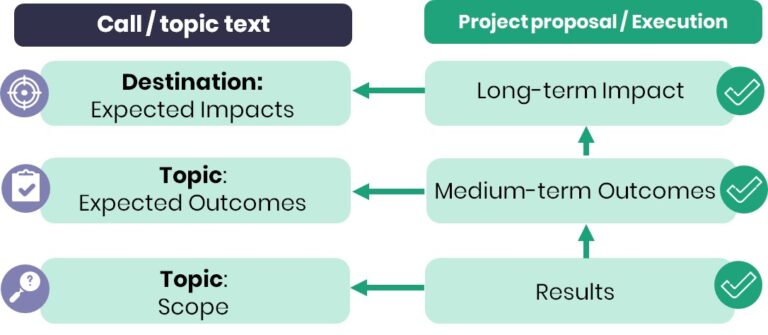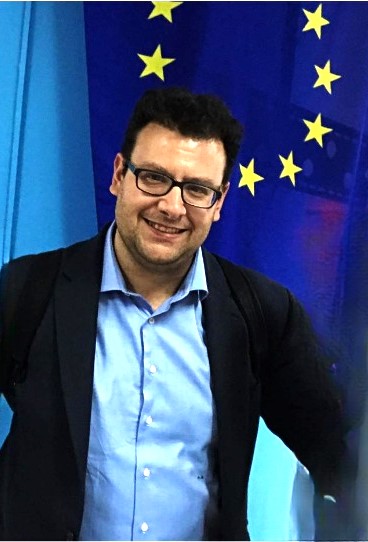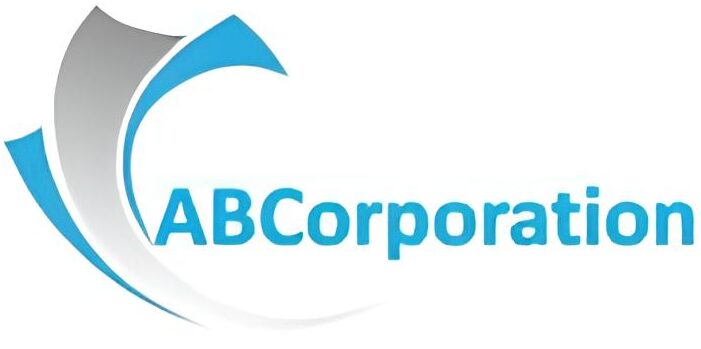How to write a successful Horizon Europe proposal: Impact section
One of the most crucial elements of Horizon Europe’s evaluation criteria is impact. As a result, careful consideration and attention should be given to the impact presentation. We outline how to approach the Horizon Europe joint project’s “Impact” section in this post, which is the first in a series on this crucial subject. We will also provide our preliminary writing advice for this area in an effort to make the proposal more competitive.
We’ll start by taking a conceptual approach to the “Impact” section. After providing an overview of the formal guidelines from the European Commission about the composition of the “Impact” section, we will conclude with some writing advice of our own.

Impact of Horizon Europe: the conceptual elements
Any research should, of course, have an impact. However, the desire to carry out the recommended research and development project drives the typical impact that many end up citing in their submission. As a direct result, many people define the impact of a project as the expected short-term outcomes. This is the first typical mistake and typically the start of the issue. In reality, a Horizon Europe project proposal’s expectations for impact go much beyond just achieving these outcomes. Let’s examine this matter more closely.
Impact extends beyond outcomes. Determine the project's value.
Even if a research project’s outcomes are crucial, they do not always indicate the project’s impact. Not only will this be a very cursory presentation that does not fully explain the impact of the project, but it will also not meet the standards set by the European Commission as they are expressed in Horizon Europe if the information in the “Impact” section is limited to the “results” obtained.
As a result, many other factors should be taken into account in the context of Impact in addition to the outcomes, some of which are anticipated to go beyond the project’s scope and duration. Thus, the appropriate formula that ultimately needs to be

AB Corporation can support you
Our track record and expertise in EU proposals are your secret weapons to achieving your goals. Numerous project consortia have benefited from the effective support of our team at AB Corporation in writing a full proposal, reviewed a re-submission, or writing certain parts . As an advocate for numerous EU-funded initiatives, we offer direction and assistance with planning, monitoring, and evaluation. Please get in touch with one of our experts if you would like more information about our project management assistance.
Contact our expert
Impact > Outcomes of the Project
Having established this, the following queries are raised: What steps do we take next? How can we close the gap that exists after the project’s outcomes?
Unlike earlier framework programs, Horizon Europe has elements and requirements in the Impact section that allow us to address these problems. But before we get into the specifics that will enable us to produce an accurate “Impact” section for Horizon Europe, we provide you with this crucial tip to help you along the way:
Substitute “value” for the term “impact.” Then, when writing the “Impact” section, consider the following queries: “What is the project’s value?” What level of significance and importance are the anticipated benefits of your project? To what extent are they prevalent?
Horizon Europe looks for innovative and ground-breaking research initiatives that really address global issues. They ought to have significant value because of this (=impact). In what other setting could researchers enthrall reviewers with the remarkable applications of their work? It has to be via the “Impact” area, surely! If properly completed, this part can greatly increase the project’s chances of getting funded.
It is the best chance to convey the project’s value and, consequently, its enormous influence in order to “sell” it. Ignoring it would be extremely detrimental to the application process overall.

Consider the following when evaluating the project's impact
• What will happen once we meet our goal and get results?
• What will occur after the project is finished?
• What further actions outside the project’s scope might be taken next?
• What “heritage” will the project have?
The Horizon Europe impact-driven strategy
In this regard, an effect-driven strategy for securing and disseminating impact has been created in order to optimize the impact of Horizon Europe initiatives. These nine core narratives correspond to the three core Impact Pathways. The European Commission wants to better inform lawmakers, budget authorities, and the public about the effects of EU spending for research and innovation (R&I). To that end, it is introducing an impact-driven approach. This strategy is in line with the goal of expanding the range of effects of EU financing for innovation and research.

Key Impact Pathways (KIPs)
- Scientific Impact: (1) Creating high-quality new knowledge; (2) Strengthening human capital in research and innovation; (3) Fostering diffusion of knowledge and Open source.
- Societal Impact: (4) Addressing EU policy priorities and global challenges through research and innovation; (5) Delivering benefits and impact through research and innovation missions; (6) Strengthening the uptake of research and innovation in society; and
- Economic / Technological Impact: (7) Generating innovation-based growth; (8) Creating more and better jobs; and (9) Leveraging investments in research and innovation.
Impact Dimensions
After working with thousands of applicants on their proposals for different framework programs, we are able to recognize a common error that occurs when submissions target too few impact dimensions (usually the ones that are relatively “easy” to obtain data for and locate supporting evidence for).
The second typical mistake made when writing the “Impact” section is this one. Because of this, many applicants have a tendency to overlook numerous other factors that are just as significant. In this situation, it is crucial to thoroughly examine every facet of the project, evaluate it critically, and identify any more dimensions that should be mentioned.
Proposals ought to make an effort to address each of the aforementioned Key Impact Pathways and their various narratives. Given that, it is best to avoid the alternative situation of trying to “cover all” of the aforementioned channels while making incredibly shaky or ambiguous connections to the project that is being offered.
The ‘Impact’ section in Horizon Europe proposals
The impact section in the Horizon Europe proposals consists of 3 sub-sections:
2.1 Project’s pathways towards impact
2.2 Measures to maximise impact
2.3 Summary canvas
2.1 Project’s pathways towards impact
This could be the most significant portion outlining the impact of the project. It is highly advised that you thoroughly review the requirements listed in this part, comprehend the evaluation standards in that context, and fulfill all obligations.
The project’s three components comprise its pathways towards impact:
1. Results: These would be the project’s instantaneous, short-term outputs. Expertise, creative ideas, algorithms, viability evidence, novel business models, policy suggestions, guidelines, demonstrators, prototypes, databases, skilled researchers, new infrastructures, networks, etc. are a few examples. The project’s outcomes must match both its goals and the parameters specified in the topic description.
2. Outcomes: These are the anticipated mid-term outcomes of projects funded under a specific subject. A project’s outputs ought to support these goals, which are especially promoted by the methods for distribution, communication, and exploitation. The project’s results ought to line up exactly with the goals specified in the topic description.
3. Impacts – These are longer-term, broader consequences on science, the economy, and society (including the environment), made possible by the results of R&I investments. They usually take place after the project is finished. Impacts should relate to the project’s particular contribution to the intended impacts of the Work Programme as outlined in the Destination, which is the area of focus for the selected topic.

The proposal language should describe in section 2.1 how the project’s concept and work plan will inform all three parts. Additionally, as shown in the following diagram, the proposal should show how each of these components would contribute to the pertinent predicted impact or impacts:

It is important as the applicant to persuade the reviewers who are perusing the project proposal that your project can practically fulfill each of these requirements when it is carried out, on all three levels:
1. The project’s outcomes ought to line up with the specifications outlined in the topic’s scope.
2. These should then result in the medium-term outcomes, which should match the goals specified in the topic description.
3. And from these should follow the long-term effect, which ought to line up with the anticipated impacts specified in the pertinent destination.
2.2 Measures to maximise impact
A strong plan that will allow the project to optimize its impact is a necessary for any Horizon Europe project, as the initiative’s impact is of the utmost importance. To achieve the maximum impact potential, a plan like this should incorporate three steps: exploitation, communication, and dissemination. Within six months of the signature date, it must be delivered as a deliverable and updated on a regular basis to reflect the project’s advancement.
2.3 Summary canvas
Subsection 2.3’s objective is to provide the reviewers with an efficient synopsis of the messages included in the “Impact” section. This is a tried-and-true method of providing the reviewer with the most important messages in an extremely effective way. This section’s table structure is specified in the Horizon Europe proposal template, and we strongly advise that you adhere to it in its entirety.
Tips from AB Corporation
- Make sure you fully familiarize yourself with the desired outcomes and wider impacts of the Destination and Work Program, as they are directly related to the topic on which your project is focused. After you’ve done so, you must provide a thorough explanation of how the results of your project will specifically contribute to these outcomes and impacts in the form of a narrative.
- Steer clear of describing shaky connections to the subject of study in general, since the possible reviewer will verify whether or not what you offer is genuinely reliable. The European Commission is seeking a specific contribution from your project to the expected outcomes related to the theme and the broader expected outcomes of the Work Programme and Destination.
- Consider starting with sub-section 2.3, “Summary canvas,” before creating the “Impact” section itself. Identifying the key points you want to make clear in this area will help you later on when you need to develop them into a strong, cohesive story, as stated in sub-section 2.1 (“project’s pathways towards impact”).
- Involving a range of stakeholders in the co-creation of your project plan from the start of proposal writing is a suggested method to guarantee strong paths to impact. There is no doubt that this strategy will provide broad advantages, much as the ones the European Commission is seeking.
- In order to receive a good score in this part, you must include baselines, benchmarks, and assumptions that illustrate our current situation as well as our projected state for the project’s completion and beyond. This can include, but is not limited to, anticipated income from new technologies, the amount of patient populations that a new therapy would impact, the number of new jobs generated by a successful project, the increase in the user base of emerging technologies, and so forth.
- It is also expected of you to identify any barriers that may arise from variables outside the purview and time frame of your project and which could affect the achievement of the desired outcomes and impacts.These could include, for instance, targeted markets for the regulatory environment, additional research and innovation projects both inside and outside of Horizon Europe, etc. After that, you will have to offer recommendations for potential ways to mitigate these barriers.
- Incorporate specific steps to maximize the impact through dissemination, exploitation, and communication activities. The prospective reviewer will assess the suggested metrics’ quality, applicability, and concreteness both during and after the project. Determine who your target audiences are for various measures as well.

AB Corporation can support you
Our track record and expertise in EU proposals are your secret weapons to achieving your goals. Numerous project consortia have benefited from the effective support of our team at AB Corporation in writing a full proposal, reviewed a re-submission, or writing certain parts . As an advocate for numerous EU-funded initiatives, we offer direction and assistance with planning, monitoring, and evaluation. Please get in touch with one of our experts if you would like more information about our project management assistance.
